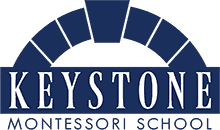Primary (ages 3-6)
The primary class, also known as The Children’s House, is for children between the ages of 3 and 6. Dr. Montessori observed that these children have what she referred to as ‘absorbent minds.’ Children of this age learn most efficiently through experience and can absorb vast amounts of knowledge quickly. They can take in all their environment offers without filtering or reasoning. This ability to absorb information makes it even more important that the primary classroom be prepared for the children with great care and attention to detail. At Keystone, children remain in the same primary class with the same teacher until they are ready to move into the elementary class.
The materials for a primary class consist of four main groups (not ‘stations’), which include practical life, sensorial, language and culture, and mathematics.
Practical Life
All children experience with lessons with practical life. These lessons include brass polishing, window cleaning, table washing, flower arranging, sewing, weaving, and grace and courtesy. Children of this age enjoy the opportunity to do work similar to what they have seen going on in their own homes. These lessons help the children to develop coordination, the ability to organize, the ability to use their hands productively, and the ability to concentrate. By working with these materials, the children learn that processes have a beginning, middle, and end. The lessons in practical life lay the foundation for all the learning that follows.
Sensorial Materials
The sensorial materials give the children the keys to their world. By exploring such materials as the Broad Stair, Pink Tower, and the Red Rods, they learn about the characteristics of things, such as “broad and narrow,” “large and small,” and “long and short.” They also learn the appropriate vocabulary associated with the materials. Their experiences with these materials allow the children to develop the ability to conceptualize these characteristics in their minds later on.
Language Materials
The language and cultural materials let the children explore again with their hands all that language can offer. Materials such as vocabulary cards, sandpaper letters, movable alphabet, and metal insets encourage the children’s independence with regard to writing, reading, and conversation. Reading is presented through a combination of phonetic and non-phonetic materials.
Mathematics
The Montessori math materials are well-recognized (and often imitated) as the best materials for helping children to understand the math processes. Their beauty and simplicity make it very clear to the children how these processes work and how they differ. In mathematics, as in other areas, the manipulation of materials brings a concrete understanding of the concepts to the young child.

